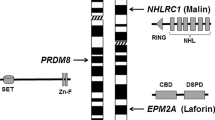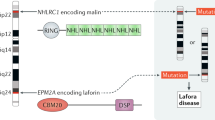Abstract
Lafora progressive myoclonus epilepsy (Lafora disease, LD) is a fatal rare autosomal recessive neurodegenerative disorder characterized by the accumulation of insoluble ubiquitinated polyglucosan inclusions in the cytoplasm of neurons, which is most commonly associated with mutations in two genes: EPM2A, encoding the glucan phosphatase laforin, and EPM2B, encoding the E3-ubiquitin ligase malin. The present study analyzes possible inflammatory responses in the mouse lines Epm2a −/− (laforin knock-out) and Epm2b −/− (malin knock-out) with disease progression. Increased numbers of reactive astrocytes (expressing the GFAP marker) and microglia (expressing the Iba1 marker) together with increased expression of genes encoding cytokines and mediators of the inflammatory response occur in both mouse lines although with marked genotype differences. C3ar1 and CxCl10 messenger RNAs (mRNAs) are significantly increased in Epm2a −/− mice aged 12 months when compared with age-matched controls, whereas C3ar1, C4b, Ccl4, CxCl10, Il1b, Il6, Tnfα, and Il10ra mRNAs are significantly upregulated in Epm2b −/− at the same age. This is accompanied by increased protein levels of IL1-β, IL6, TNFα, and Cox2 particularly in Epm2b −/− mice. The severity of inflammatory changes correlates with more severe clinical symptoms previously described in Epm2b −/− mice. These findings show for the first time increased innate inflammatory responses in a neurodegenerative disease with polyglucosan intraneuronal deposits which increase with disease progression, in a way similar to what is seen in neurodegenerative diseases with abnormal protein aggregates. These findings also point to the possibility of using anti-inflammatory agents to mitigate the degenerative process in LD.





Similar content being viewed by others
References
Delgado-Escueta AV (2007) Advances in lafora progressive myoclonus epilepsy. Curr Neurol Neurosci rep 7:428–433
Monaghan TS, Delanty N (2010) Lafora disease: epidemiology, pathophysiology and management. CNS drugs 24:549–561
Lohi H, Ianzano L, Zhao XC, Chan EM, Turnbull J, Scherer SW, Ackerley CA, Minassian BA (2005) Novel glycogen synthase kinase 3 and ubiquitination pathways in progressive myoclonus epilepsy. Hum Mol Genet 14:2727–2736
Rubio-Villena C, Garcia-Gimeno MA, Sanz P (2013) Glycogenic activity of R6, a protein phosphatase 1 regulatory subunit, is modulated by the laforin-malin complex. Int J Biochem Cell Biol 45:1479–1488
Worby CA, Gentry MS, Dixon JE (2008) Malin decreases glycogen accumulation by promoting the degradation of protein targeting to glycogen (PTG). J Biol Chem 283:4069–4076
Solaz-Fuster MC, Gimeno-Alcaniz JV, Ros S, Fernandez-Sanchez ME, Garcia-Fojeda B, Criado Garcia O, Vilchez D, Dominguez J et al (2008) Regulation of glycogen synthesis by the laforin-malin complex is modulated by the AMP-activated protein kinase pathway. Hum Mol Genet 17:667–678
Wang J, Stuckey JA, Wishart MJ, Dixon JE (2002) A unique carbohydrate binding domain targets the Lafora disease phosphatase to glycogen. J Biol Chem 277:2377–2380
Worby CA, Gentry MS, Dixon JE (2006) Laforin, a dual specificity phosphatase that dephosphorylates complex carbohydrates. J Biol Chem 281:30412–30418
Tagliabracci VS, Turnbull J, Wang W, Girard JM, Zhao X, Skurat AV, Delgado-Escueta AV, Minassian BA et al (2007) Laforin is a glycogen phosphatase, deficiency of which leads to elevated phosphorylation of glycogen in vivo. Proc Natl Acad Sci U S A 104:19262–19266
Garyali P, Siwach P, Singh PK, Puri R, Mittal S, Sengupta S, Parihar R, Ganesh S (2009) The malin-laforin complex suppresses the cellular toxicity of misfolded proteins by promoting their degradation through the ubiquitin-proteasome system. Hum Mol Genet 18:688–700
Liu Y, Wang Y, Wu C, Liu Y, Zheng P (2009) Deletions and missense mutations of EPM2A exacerbate unfolded protein response and apoptosis of neuronal cells induced by endoplasm reticulum stress. Hum Mol Genet 18:2622–2631
Vernia S, Rubio T, Heredia M, Rodriguez de Cordoba S, Sanz P (2009) Increased endoplasmic reticulum stress and decreased proteasomal function in Lafora disease models lacking the phosphatase laforin. PLoS One 4:e5907
Zeng L, Wang Y, Baba O, Zheng P, Liu Y (2012) Laforin is required for the functional activation of malin in endoplasmic reticulum stress resistance in neuronal cells. The FEBS journal 279(14):2467–2478
Rao SN, Maity R, Sharma J, Dey P, Shankar SK, Satishchandra P, Jana NR (2010) Sequestration of chaperones and proteasome into Lafora bodies and proteasomal dysfunction induced by Lafora disease-associated mutations of malin. Hum Mol Genet 19:4726–4734
Rao SN, Sharma J, Maity R, Jana NR (2010) Co-chaperone CHIP stabilizes aggregate-prone malin, a ubiquitin ligase mutated in Lafora disease. J Biol Chem 285:1404–1413
Aguado C, Sarkar S, Korolchuk VI, Criado O, Vernia S, Boya P, Sanz P, de Cordoba SR et al (2010) Laforin, the most common protein mutated in Lafora disease, regulates autophagy. Hum Mol Genet 19:2867–2876
Criado O, Aguado C, Gayarre J, Duran-Trio L, Garcia-Cabrero AM, Vernia S, San Millan B, Heredia M et al (2012) Lafora bodies and neurological defects in malin-deficient mice correlate with impaired autophagy. Hum Mol Genet 21:1521–1533
Garcia-Gimenez JL, Seco-Cervera M, Aguado C, Roma-Mateo C, Dasi F, Priego S, Markovic J, Knecht E et al (2013) Lafora disease fibroblasts exemplify the molecular interdependence between thioredoxin 1 and the proteasome in mammalian cells. Free Radic Biol Med 65:347–359
Roma-Mateo C, Aguado C, Garcia-Gimenez JL, Ibanez-Cabellos JS, Seco-Cervera M, Pallardo FV, Knecht E, Sanz P (2015) Increased oxidative stress and impaired antioxidant response in Lafora disease. Mol Neurobiol 51:932–946
Roma-Mateo C, Aguado C, Luis Garcia-Gimenez J, Knecht E, Sanz P, Pallardo FV (2015) Oxidative stress, a new hallmark in the pathophysiology of Lafora progressive myoclonus epilepsy. Free Radic Biol Med 88(Pt A):30–41
Kiffin R, Bandyopadhyay U (2006) Cuervo AM (2006) Oxidative stress and autophagy. Antioxid Redox Signal 8:152–162
Lee J, Giordano S, Zhang J (2012) Autophagy, mitochondria and oxidative stress: cross-talk and redox signalling. Biochem J 441:523–540
Dutta D, Xu J, Kim JS, Dunn WA Jr (2013) Leeuwenburgh C (2013) Upregulated autophagy protects cardiomyocytes from oxidative stress-induced toxicity. Autophagy 9:328–344
Navarro-Yepes J, Burns M, Anandhan A, Khalimonchuk O, Del Razo LM, Quintanilla-Vega B, Pappa A, Panayiotidis MI et al (2014) Oxidative stress, redox signaling, and autophagy: cell death versus survival. Antioxid Redox Signal 21:66–85
Duran J, Gruart A, Garcia-Rocha M, Delgado-Garcia JM, Guinovart JJ (2014) Glycogen accumulation underlies neurodegeneration and autophagy impairment in Lafora disease. Hum Mol Genet 23:3147–3156
Berthier A, Paya M, Garcia-Cabrero AM, Ballester MI, Heredia M, Serratosa JM, Sanchez MP, Sanz P (2015) Pharmacological interventions to ameliorate neuropathological symptoms in a mouse model of Lafora disease. Mol Neurobiol doi:10.1007/s12035-015-9091-8
McGeer EG, Klegeris A, McGeer PL (2005) Inflammation, the complement system and the diseases of aging. Neurobiol Aging 26(Suppl 1):94–97
Graeber MB, Streit WJ (2010) Microglia: biology and pathology. Acta Neuropathol 119:89–105
Heneka MT, Kummer MP, Latz E (2014) Innate immune activation in neurodegenerative disease. Nat Rev Immunol 14:463–477
López González I, Garcia-Esparcia P, Llorens F, Ferrer I (2016) Genetic and transcriptomic profiles of inflammation in neurodegenerative diseases: Alzheimer, Parkinson, Creutzfeldt-Jakob and tauopathies. Int J Mol Sci (Epub ahead of print)
Ganesh S, Delgado-Escueta AV, Sakamoto T, Avila MR, Machado-Salas J, Hoshii Y, Akagi T, Gomi H et al (2002) Targeted disruption of the Epm2a gene causes formation of Lafora inclusion bodies, neurodegeneration, ataxia, myoclonus epilepsy and impaired behavioral response in mice. Hum Mol Genet 11:1251–1262
García-Cabrero AM, Marinas A, Guerrero R, de Córdoba SR, Serratosa JM, Sanchez MP (2012) Laforin and malin deletions in mice produce similar neurologic impairments. J Neuropathol Exp Neurol 71:413–421
Llorens F, López-González I, Thüne K, Carmona M, Zafar S, Andréoletti O, Zerr I, Ferrer I (2014) Subtype and regional-specific neuroinflammation in sporadic Creutzfeldt-Jakob disease. Front Aging Neurosci 6:198
López-González I, Aso E, Carmona M, Armand-Ugon M, Blanco R, Naudí A, Cabré R, Portero-Otin M et al (2015) Neuroinflammatory gene regulation, mitochondrial function, oxidative stress, and brain lipid modifications with disease progression in tau P301S transgenic mice as a model of frontotemporal lobar degeneration-tau. J Neuropathol Exp Neurol 74:975–999
López-González I, Schlüter A, Aso E, Garcia-Esparcia P, Ansoleaga B, LLorens F, Carmona M, Moreno J et al (2015) Neuroinflammatory signals in Alzheimer’s disease and APP/PS1 transgenic mice: correlations with plaques, tangles, and oligomeric species. J Neuropathol Exp Neurol 74:319–344
López-González I, Pérez-Mediavilla A, Zamarbide M, Carmona M, Torrejón Escribano B, Glatzel M, Galliciotti G, Ferrer I (2016) Limited unfolded protein response and inflammation in neuroserpinopathy. J Neuropathol Exp Neurol (Epub ahead of print)
Svahn AJ, Becker TS, Graeber MB (2014) Emergent properties of microglia. Brain Pathol 24:665–670
Acknowledgements
This study was funded by the Ministerio de Ciencia e Innovación, Instituto de Salud Carlos III—Fondos FEDER, a way to build Europe FIS grants PI14/00757 and PI14/00328 to IF, and grants from the Spanish Ministry of Economy and Competiveness SAF2014-54604-C3-1-R and from the Generalitat Valenciana (PrometeoII/2014/029) to PS. We thank T. Yohannan for the editorial assistance.
Author information
Authors and Affiliations
Corresponding authors
Ethics declarations
This study was carried out in strict accordance with the recommendations in the Guide for the Care and Use of Laboratory Animals of the Consejo Superior de Investigaciones Cientificas (CSIC, Spain). All mouse procedures were approved by the animal committee of the Instituto de Biomedicina de Valencia-CSIC [Permit Number: INTRA12 (IBV-4)]. All efforts were made to minimize animal suffering.
Financial Disclosure and Conflict of Interests
No relevant data.
Statement of Author Contributions
I.L.-G. carried out the analysis of gene and protein expression; R.V. did the immunohistochemical study; P.S. and I.F. designed and supervised the work. All authors were involved in writing the paper and had final approval of the submitted and published version.
Additional information
Irene López-González and Rosa Viana contributed equally to this work.
Rights and permissions
About this article
Cite this article
López-González, I., Viana, R., Sanz, P. et al. Inflammation in Lafora Disease: Evolution with Disease Progression in Laforin and Malin Knock-out Mouse Models. Mol Neurobiol 54, 3119–3130 (2017). https://doi.org/10.1007/s12035-016-9884-4
Received:
Accepted:
Published:
Issue Date:
DOI: https://doi.org/10.1007/s12035-016-9884-4




